Summary
This blog reviews E27 or B22 style LED bulbs and the heat produced during operation.
LED Bulbs
In many mains powered LED bulbs a non-isolated, AC to DC LED driver is central to the design. For some bulbs, the Printed Circuit Assembly (PCA) containing the LED driver is separate from the LEDs. The LED Printed Circuit Board (PCB) is usually metal backed to assist in heat dissipation. Both the LEDs and driver assemblies generate heat however the majority of heat is generated by the LEDs.
Failed LED Bulbs
After several LED bulbs failed across a period of weeks whilst daytime temperatures were high, the bulbs were opened for investigation. A failed Surface Mount (SMT) LED on the PCA was easily identified by black dots. Other LED bulbs had failed controllers.
| Single Failed LED (Black Dots) |
LED Testing
The LED driver on the bulbs was identified from the manufacturer Bright Power Semiconductor. The manufacturer datasheet detailed the LED driver‘s single string capability was 120 mA with a maximum string voltage of DC 72 V.
Based on the driver string voltage, current with the dimensions of the LED in the bulb, the LED manufacturer appeared to be Everlight however this is not substantiated.
Using the specifications of the Everlight LED as a reference; a forward voltage of 9.15 V and 100 mA maximum current, a single LED board was left on the board. The single LED was powered from a benchtop power supply and measurements were taken.
For a constant current of 100 mA, the forward voltage was approximately 9.1 V. Measuring the temperature of the single LED after 15 min showed the case temperature of the LED reached 85°C mounted against the metallised board.
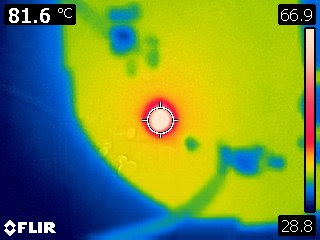 |
| Temperature of LED Case |
The rear of the metallised board reached nearly 40°C in the open air. When installed in the bulb, the temperature of the metallised board is expected to be higher considering the enclosed space.
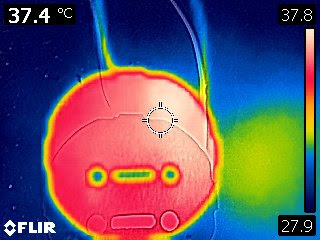 |
| Temperature of LED Rear Side |
Changing the power supply to constant voltage mode with a 125 mA current limit, several measurements were performed at different voltages. Temperature measurements were also performed with a 26°C ambient. The graphed results are illustrated below.
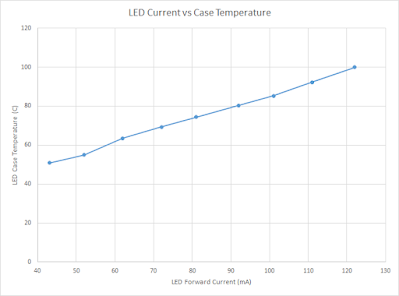 | |
|
Summary
During the testing process in this blog, a maximum LED case temperature of 101°C was measured with an ambient of 26°C.
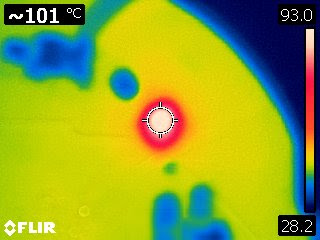 |
| Highest LED Temperature |
It should be noted that many LEDs will operate continuously with a junction temperature at or above 100°C. Manufacturer datasheets usually provide graphs showing luminous flux changes with temperature which help determine derating performance.
The derating of luminous flux versus temperature varies considerably between LED manufacturers. For the LED described in the blog, which was suspected to be manufactured by Everlight, the maximum junction temperature was 115°C. The derating curve to 115°C is shown below.
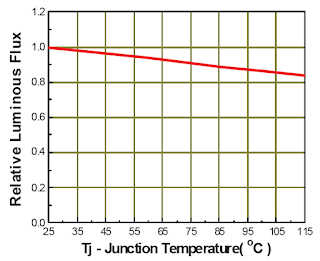 |
| Everlight Luminous Flux vs Temperature |
Using the bench tests results from this blog, it would be anticipated that with all LEDs active and an ambient temperature over 40°C, the LED junction temperature would exceed the datasheet rating.
| LED Bulb Driver and LED PCA's Showing Heat Discolouration |
Interestingly many over the shelf LED bulbs do not detail maximum operating temperatures on their packaging or datasheets. For the LED bulb described in this blog, the high generated temperature was likely a contributing factor to the reduced lifetime of the bulb.
